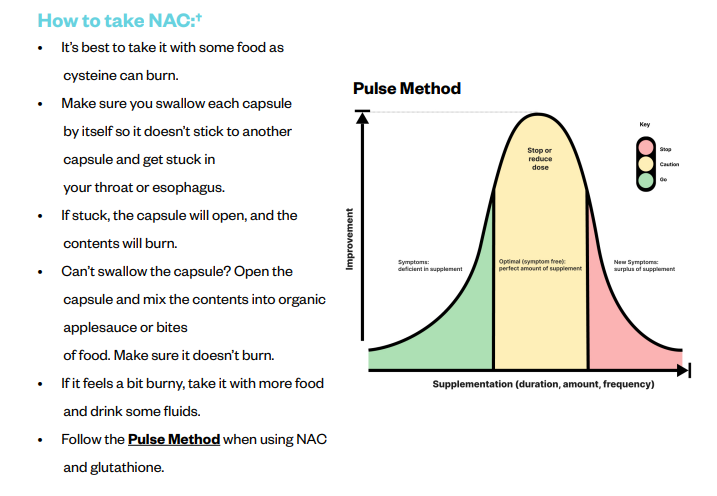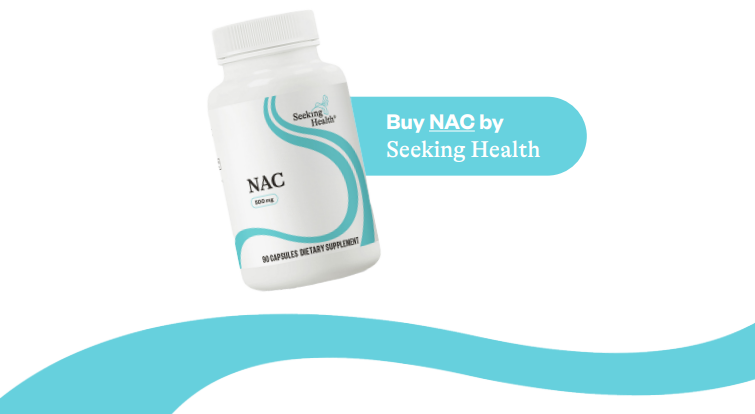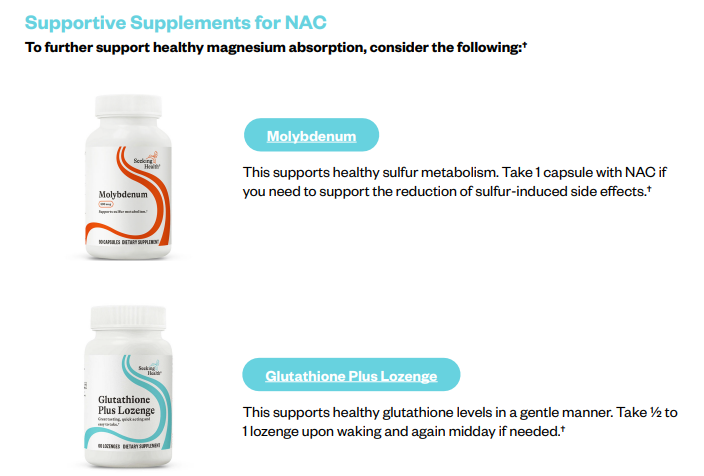How to use NACUpdated 2 months ago

Without cysteine, your body’s ability to fight oxidative stress, eliminate chemicals, and maintain cellular health diminishes rapidly. A cysteine deficiency can lead to severe issues such as low immunity, rapid weight loss, poor detoxification, and accelerated aging. For those with underlying conditions or poor diets, cysteine deficiency is a silent, albeit serious issue.
Over the past 25 years, more than 102 trials have studied the effects of N-acetyl cysteine (NAC) and cysteine. 72 report beneficial outcomes.1
As a result, it’s been found that cysteine, the key nutrient in NAC, supports the following areas of health:†
| • Hormones | • Heart5,6 |
| • Metabolism2 | • Bones28 |
| • Immune system3 | • Liver6 |
| • Respiratory system4 | • Brain6 |
| • Hair, skin, and nails28 |
Why does cysteine support these areas of health?†
• Cysteine is glutathione's main component, which has antioxidant-like properties.7
• It supports healthy immune system regulation and, thus, a healthy inflammatory response.26, 27
• Collagen and keratin formation relies on cysteine.
• Cysteine supports healthy hydrogen sulfide levels, which are essential for healthy breathing, blood flow, and mitochondrial function.
• It acts as a mucolytic, which means it can support the normal breakdown of excessive mucus. 27
What symptoms are associated with an NAC or cysteine deficiency?
• A reduced ability to neutralize free radicals, leading to oxidative stress. This contributes to a myriad of problems, from achy joints, headaches, mood imbalances, cardiovascular issues, and uncontrolled cellular growth, to name a few.
• Hair loss, hair breakage, poor skin elasticity, and brittle nails are commonly associated with cysteine deficiency.41 Cysteine is a must for keratin and collagen formation.
• Difficulty with breathing due to excessive, thick mucus commonly found in the sinuses and lungs.
• Difficulty with breathing due to low hydrogen sulfide production.40
• Rapid weight loss may be seen for many complicated reasons.37
• Low cysteine levels break intestinal wall sulfur-containing bonds. These broken walls lead to leaky gut, which increases the exposure to pathogens, chemicals, and food intolerances.36
• A weakened immune system, as excessive oxidative stress caused by low cysteine levels hampers a healthy immune response.
• Low energy and increased fatigue due to low glutathione levels. Low glutathione reduces the ability to generate energy from your mitochondria.42
• Sensitivity to smells, odors, and chemicals due to low cysteine as it is needed to make glutathione.39
Who is most at risk for a deficiency of cysteine?1,29, 30
While many can obtain cysteine through a healthy diet, there are certain populations that require additional attention to avoid deficiency:
• The elderly
• Those who are pregnant or breastfeeding. Low cysteine levels can negatively impact fetal development.
• Those who chronically use alcohol
• Individuals living with ongoing illnesses
• High-carb, low-protein dieters
• Vegans and vegetarians (cysteine is found in meat products)
• Those receiving long-term parenteral nutrition (TPN)
Who should be careful supplementing with cysteine?
• Those experiencing signs of excessive sulfur
• Those having loose stools (sulfur supplements can make you worse)
• Those with an inflammatory bowel condition (do not take more sulfur)
What are the main known health benefits of cysteine (and NAC)?†
• Healthy detoxification support via glutathione production, helping to support the normal elimination of harmful chemicals and pathogens8
• Mucus and respiratory health4
• Supports positive mental health9,10
• Support healthy liver function11
• Neurotransmitter balance support, especially dopamine and glutamate, which can be beneficial for individuals with addictions or neurodiverse conditions12,13
• Male and female fertility support14,15
• Polycystic ovarian syndrome (PCOS) support2
• Healthy heart, blood flow, and blood pressure support5,6
Foods that contain cysteine (found in NAC):
• Pork: 600 mg per 6 oz serving
• Beef: 590 mg per 6 oz serving
• Chicken: 570 mg per 6 oz serving
• Tuna: 550 mg per 6 oz serving
• Eggs: 150 mg per 1 large egg
• Sunflower seeds: 100 mg per 1 oz
What increases the loss of cysteine or the need for glutathione?
Cysteine deficiency, and thus low glutathione, isn’t just a minor gap in nutritional support. It’s a hidden driver of many chronic diseases which lead to poor health outcomes. Addressing the driving causes of loss of cysteine must be done:
| • Low dietary intake16 | • Alcohol22 |
| • Oxidative stress (free radicals)17 | • Acetaminophen23 |
| • Inflammation17 | • NSAIDS (aspirin, ibuprofen)24 |
| • Exercise18 | • Steroids (prednisone, cortisone) |
| • Antacids19 | • Antibiotics |
| • High protein diet due to increasing homocysteine level | • Tricyclic antidepressants |
| • High fructose corn syrup (lowers glutathione which lowers cysteine)21 | • Increased metabolism |
| • Obesity |
Cysteine deficiency really hurts glutathione levels.25
• Low cysteine literally destroys your glutathione levels.
• If you don't get enough cysteine, your body increases cysteine levels by breaking down glutathione.
How long does cysteine last in your body?32
• Cysteine is not stored in body tissues very well by design.
• The half-life of cysteine is about 6 hours, which means that after 6 hours of not eating any cysteine, 50% of your cysteine would be used up by the body.
• Within days, symptoms of cysteine deficiency can be readily apparent. See the list above.
Why isn’t cysteine stored in the body long term?31, 38
• Cysteine is not heavily stored like a fat-soluble vitamin, such as Vitamin D.
• While extremely important, cysteine can convert readily into a reactive cysteine compound.
• Cysteine further promotes inflammation and oxidative damage when combined with inflammatory processes, iron, copper, and free radicals.
Does NAC make Glutathione?
• People often think that by taking NAC, they are making glutathione, but that’s not guaranteed.
• NAC is the primary ingredient for glutathione, but it is not the only one.
• Without cysteine, glutathione will not be produced.
• To produce glutathione, the body needs cysteine, glycine, glutamate, magnesium, and adenosine triphosphate (ATP).
• Even with all the above nutrients, you may still be unable to convert them into glutathione.
• Mycotoxins and infections block the ability of NAC to convert into glutathione.33, 34
• If you are looking for healthy glutathione levels, consider supplementing with Glutathione Plus Lozenges, and take 1 lozenge upon waking.†
If I take NAC, do I have to take Glutathione?†
• If you’re experiencing benefits from just taking NAC, then you may not need to take glutathione.
• If you’re taking NAC and still struggling with symptoms, you may need to either stop taking NAC and just take the glutathione or take both.
• You will need to experiment based on how you feel. You may do well with just NAC, you may need both NAC and glutathione, or you may just do well from glutathione.
• Note that this can change for many biochemical reasons, so continue experimenting as needed.
Can I take NAC and Glutathione at the same time?†
• It’s best to take one or the other.
• Start with either NAC or glutathione, and take it for a few days.
• Watch out for signs of excessive cysteine or sulfur
Signs of excessive use of cysteine (from NAC, food, or sulfur):
We tend to get excited about a new supplement. NAC is great, as is glutathione. But be mindful that taking too much can lead to unpleasant side effects. Thankfully, these go away quite quickly once stopped.
| • Bloody nose | • Headaches |
| • Nausea | • Dry eyes |
| • Vomiting | • Dry sinuses |
| • Skin reactions (redness, itching, hot) | • Dizziness |
| • Loose stools | • Increased asthma risk (Hydrogen sulfide gas made from cysteine has a sweet spot. Too little increases asthma risk, and so does too much.)40 |
| • Burning stools | |
| • Sulfur-smelling stools, armpits, breath |
How to counter the side effects of excessive cysteine:
• Within a day, you can typically reverse the uncomfortable side effects caused by excess cysteine.
• Stop using cysteine and sulfur-containing supplements.
• Stop consuming cruciferous vegetables.
• Limit protein intake to no more than half your body weight. Example: A 160 lb person needs no more than 80 g of protein for a few days.
• Supplement with Molybdenum, and Calcium D Glucarate.† These support healthy sulfur metabolism.
Which lab tests should be used to measure cysteine?25
• GGT: This shows how much glutathione is being pumped out of the cells and broken down to replenish cysteine levels. If GGT is elevated, then it’s known that cysteine and glutathione levels are low.
• Plasma amino acids test: Tests for cysteine and other amino acids. Do this test fasted. Do not eat after dinner, and do the blood draw the next morning.

When to take NAC:†
• You can take NAC any time of day or night.
• If you are taking NAC to support a healthy respiratory system (sinuses and lungs), then it may be best to take NAC in the morning and afternoon, not at night.
• If taken at night when congested or coughing, the NAC may trigger the breaking up of mucus, and thus, you may be coughing all night long.
How much NAC should I take?†
• As with most supplements, take as needed.
• The dosage varies depending on the condition and what you’re supporting.
• Typically, 1 capsule of 500 mg a day of NAC is sufficient.
• Children may take ½ capsule mixed in a bite of food like organic applesauce.
• NAC is safe for pregnancy typically, but talk with your health professional.
• It may be best to use a lower potency glutathione supplement like Glutathione Plus Lozenge for pregnancy, breastfeeding, and children.
• There are times when your health professional may recommend taking 1-2 grams of NAC two to three times a day


What are ways to support NAC?†
1. Coughing? Adding a humidifier, steam room, or wet sauna is a great way to support healthy respiration and break up thick mucus.
2. Do not consume dairy products while coughing, as dairy is full of mucus naturally and can make coughing and sinuses worse.
3. Crush garlic cloves, place them on a small dish, and put them on your desk or by your bed. Inhale it indirectly all day and night.
Always consult with a healthcare professional before starting any new supplement, especially at higher doses.
References
1. https://herzenberglab.stanford.edu/sites/g/files/sbiybj27506/files/media/file/lah579_cysdef.pdf?t 2. https://pubmed.ncbi.nlm.nih.gov/37841396/
3. https://www.frontiersin.org/journals/immunology/articles/10.3389/fimmu.2017.01239/full
4. https://pmc.ncbi.nlm.nih.gov/articles/PMC7892733/
5. https://pubmed.ncbi.nlm.nih.gov/29623672/
6. https://www.nature.com/articles/s41598-022-05632-x
7. https://pmc.ncbi.nlm.nih.gov/articles/PMC8234027/
8. https://link.springer.com/chapter/10.1007/978-981-10-5311-5_10
9. https://pubmed.ncbi.nlm.nih.gov/27137430/
10. https://pubmed.ncbi.nlm.nih.gov/26931055/
11. https://pmc.ncbi.nlm.nih.gov/articles/PMC5241507/
12. https://pmc.ncbi.nlm.nih.gov/articles/PMC5993450/
13. https://pmc.ncbi.nlm.nih.gov/articles/PMC5241507/
14. https://pmc.ncbi.nlm.nih.gov/articles/PMC4845522/
15. https://pmc.ncbi.nlm.nih.gov/articles/PMC9577027/
16. https://pmc.ncbi.nlm.nih.gov/articles/PMC11312522/
17. https://www.mdpi.com/2076-3921/13/3/267
18. https://www.frontiersin.org/journals/physiology/articles/10.3389/fphys.2020.609335/full
19. https://go.drugbank.com/drugs/DB06151
20. https://pmc.ncbi.nlm.nih.gov/articles/PMC8196702/?t
21. https://pmc.ncbi.nlm.nih.gov/articles/PMC6262252/?t
22. https://www.nature.com/articles/s41598-021-92676-0
23. https://pubmed.ncbi.nlm.nih.gov/2721538/
24. https://pubmed.ncbi.nlm.nih.gov/12913268/
25. https://www.nature.com/articles/srep30033?t
26. https://pubmed.ncbi.nlm.nih.gov/21986479/
27. https://www.mountsinai.org/health-library/supplement/cysteine?t
28. https://pmc.ncbi.nlm.nih.gov/articles/PMC6017824/?t
29. https://pmc.ncbi.nlm.nih.gov/articles/PMC7551827/?t
30. https://www.frontiersin.org/journals/aging/articles/10.3389/fragi.2022.852569/full?t
31. https://pmc.ncbi.nlm.nih.gov/articles/PMC6562400/
32. https://pmc.ncbi.nlm.nih.gov/articles/PMC3942754/
33. https://onlinelibrary.wiley.com/doi/10.1155/2012/734125
34. https://herzenberglab.stanford.edu/sites/g/files/sbiybj27506/files/media/file/ lah579_cysdef.pdf?t
35 https://herzenberglab.stanford.edu/sites/g/files/sbiybj27506/files/media/file/lah579_cysdef.pdf?t
36. https://pmc.ncbi.nlm.nih.gov/articles/PMC10769047/?t
37. https://www.biorxiv.org/content/10.1101/2024.07.30.605703v1.full?t
38. https://journals.asm.org/doi/10.1128/jb.185.6.1942-1950.2003?t
39. https://pmc.ncbi.nlm.nih.gov/articles/PMC7120747/?t
40. https://pmc.ncbi.nlm.nih.gov/articles/PMC8147381/ BENEFI BENEFI TS†S† T
41. https://www.ajmc.com/view/alopecia-areata-hair-breakage-linked-to-cysteine-deficiency?t https:// pubmed.ncbi.nlm.nih.gov/31452142/
42. https://pubmed.ncbi.nlm.nih.gov/31452142/
†These statements have not been evaluated by the Food and Drug Administration. This product is not int